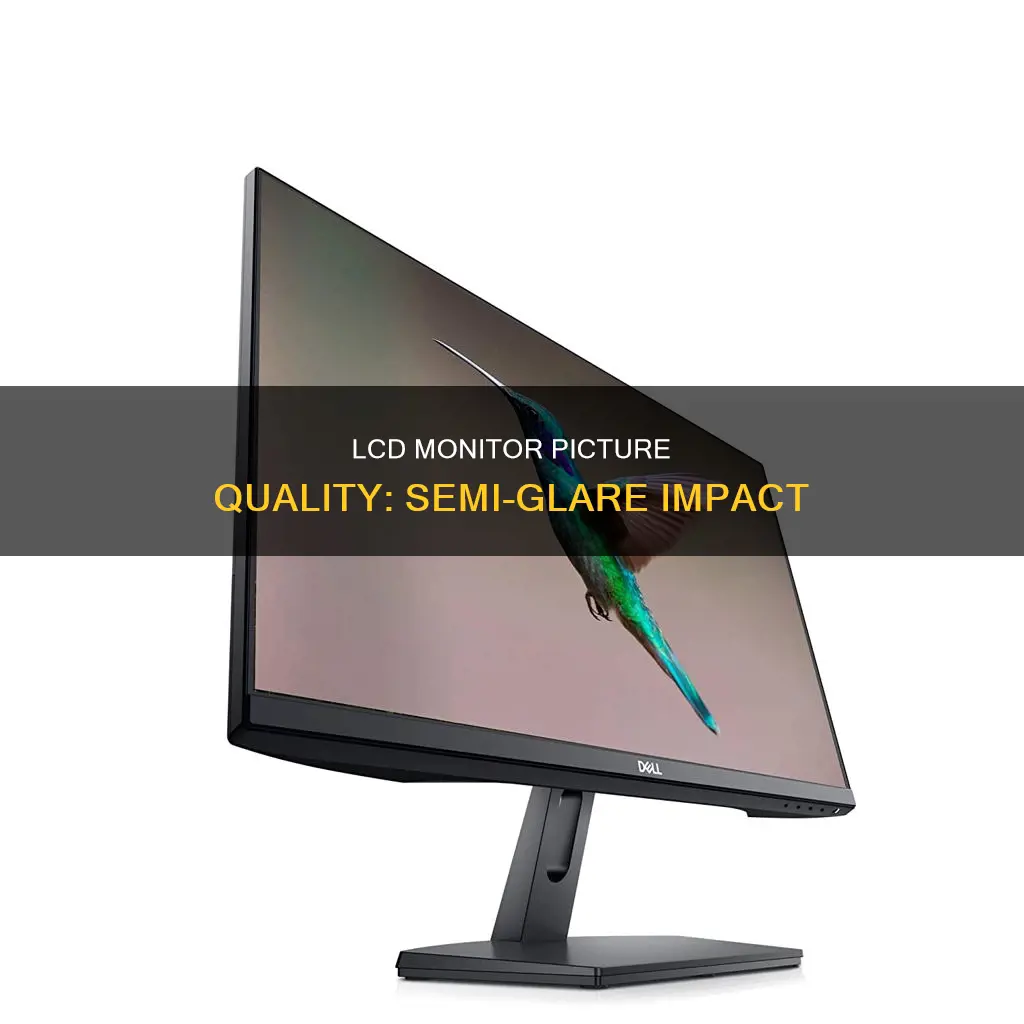
Glare on a computer screen can be annoying and even cause eye strain. LCD monitors with a semi-glare or semi-glossy finish are a hybrid between matte and glossy screens, reflecting less light than a glossy screen but making colours appear more vivid than a matte screen. While a matte finish can make colours seem hazy, a glossy finish can be too reflective, so a semi-glare finish can be a good compromise. However, the effectiveness of an anti-glare treatment depends on its haze value and the screen surface. A higher haze value means better reflection handling but adds more graininess, so a light or medium matte anti-glare coating (around 25% haze) is ideal as it helps with reflections without affecting image quality.
What You'll Learn

The impact of room lighting on picture quality
The lighting in a room can have a significant impact on the picture quality of a semi-glare LCD monitor. While these monitors are designed to reduce glare, the lighting conditions in a room can still affect the viewing experience. Here are some factors to consider:
Type of Lighting
The type of lighting in the room can influence the amount of glare on the screen and the perceived picture quality. For example, fluorescent lighting or standard household incandescent lights can make white and grey colours appear reddish or greenish, respectively. In contrast, a high colour temperature setting on the monitor can make these colours appear bluish.
Lighting Brightness
The brightness of the lighting in the room can also affect the viewing experience. In a well-lit room, there may be issues with glare on the screen, making it difficult to see the display properly. On the other hand, in a dimly lit room, it may be necessary to increase the monitor's brightness to improve visibility.
Direction of Lighting
The direction of the light source can play a role in the amount of glare on the screen. If light is shining directly on the monitor, such as through a window with direct sunlight, it can cause distracting reflections. Adjusting the position of the monitor away from direct light sources can help mitigate this issue.
Room Colour
The colour of the room can also influence the perceived colours on the monitor. For example, if the room has coloured lighting or walls, it can affect how colours are displayed on the screen, potentially causing colour casts or shifts.
Lighting Temperature
The temperature of the lighting can impact the viewing experience. For instance, a cold white light can cause eye fatigue and make it more challenging to focus on the screen. Adjusting the colour temperature of the lighting or using software like F.lux to change the screen temperature can help alleviate this issue.
Lighting Uniformity
The uniformity of lighting in the room can also be a factor. If there are bright spots or uneven lighting, it can affect how the monitor displays colours and brightness. A uniformly lit room can provide a more consistent viewing experience.
In summary, while semi-glare LCD monitors are designed to reduce glare, the lighting conditions in the room can still impact the picture quality. Adjusting factors such as lighting type, brightness, direction, room colour, temperature, and uniformity can help optimise the viewing experience and reduce potential issues with glare and colour accuracy.
Activating FPS Mode on Your ASUS Monitor: A Step-by-Step Guide
You may want to see also

Matte vs glossy screens
When it comes to matte vs glossy screens, there are several factors to consider, including image quality, glare, and reflection. While matte screens reduce reflections and glare, they can make the image appear slightly fuzzy or hazy. On the other hand, glossy screens offer more vivid and intense picture quality but are highly reflective and prone to smudges and fingerprints.
Matte screens are the most common type of screen finish for monitors and are designed to reduce glare and reflections. They feature an etched plastic surface with grooves or indentations that scatter light, minimising the impact of reflections on the screen. While this makes matte screens ideal for well-lit environments, the etching process can result in a slightly dull or fuzzy image. Additionally, dust is less visible on matte screens, and they are more comfortable for your eyes due to the reduced glare.
Glossy screens, on the other hand, use reflective glass or polymers that allow almost all of the display's light output to show through, resulting in deeper blacks, brighter whites, and richer colours. This makes glossy screens ideal for dark or dimly lit rooms, as they offer more vivid colours and expressive contrast. However, they perform poorly under heavy sunlight or bright room lighting, becoming mirror-like and causing eye strain due to glare.
Ultimately, the choice between matte and glossy screens depends on personal preference and the lighting conditions in which the screen will be used. If you're looking for a screen to use outdoors or in a well-lit environment, a matte screen is the better option. On the other hand, if you spend most of your time in a dimly lit room, a glossy screen will provide a more vibrant viewing experience.
It's worth noting that there are also semi-glossy or light-matte screen finishes available, which offer a balance between the two extremes. These finishes have a lower haze value, resulting in a less grainy image but increased reflectivity compared to standard matte screens. Additionally, some glossy screens feature anti-glare or anti-reflective treatments, which help reduce glare without significantly impacting image quality.
Monitoring App Usage: iPad Settings for Parents and Guardians
You may want to see also

How to adjust monitor tilt to reduce glare
Glare on computer monitors can cause eye strain, headaches, and fatigue. It is important to reduce glare to improve the quality of your work environment and reduce the risk of eye strain and other health issues.
The easiest way to reduce glare is to adjust the monitor tilt and swivel away from the source of light. Here are some steps you can take to adjust your monitor tilt to reduce glare:
- Adjust the monitor along one axis slowly, keeping an eye on reflections and glare.
- Stop adjusting when you reach the point that is easiest on your eyes from your usual viewing distance.
- Repeat the process with the other axis, if your monitor allows it.
- If your monitor doesn't swivel, you can also rotate the monitor from its base. Ensure that it stays at a comfortable viewing angle for you.
Additionally, you can try to reduce glare by adjusting the brightness and contrast of your monitor, using curtains or blinds to reduce the amount of light entering the room, and incorporating task lighting, such as a desk lamp, positioned so that it doesn't reflect off the screen.
You can also use third-party accessories, such as a glare guard, monitor visor, or a high-quality polarized light filter, to further reduce glare and unwanted reflections, especially if your workstation is near a window or another source of natural sunlight.
Attaching Your ASUS Monitor to a Wall Mount: Easy Steps
You may want to see also

The effect of brightness on picture quality
The brightness of a display can have a significant impact on picture quality, especially when it comes to LCD monitors. Brightness plays a crucial role in how well we can see an image on a screen and how accurately colours are reproduced. Let's explore the various factors that contribute to the relationship between brightness and picture quality.
Ambient Lighting Conditions
The amount of ambient light in the room or environment where the LCD monitor is placed can greatly affect the perceived picture quality. If the room is too bright or there are direct light sources shining on the screen, such as lamps or sunlight through windows, the display may appear washed out or difficult to see due to glare. This is where features like anti-glare coatings and different screen finishes come into play.
Anti-Glare Coatings
An anti-glare screen is designed to minimise reflections by diffusing light instead of reflecting it directly. This can be particularly helpful in reducing glare and improving visibility in bright environments. However, it's important to note that anti-glare treatments can also make the picture appear more grainy, depending on the haze value of the coating.
Screen Finishes
There are typically three types of screen finishes: matte, semi-glossy, and glossy. Matte finishes are the most common for monitors as they effectively reduce reflections and glare. While they may make colours appear less vivid and slightly fuzzy, they are well-suited for bright rooms. Glossy finishes, on the other hand, enhance colour vividness and improve picture quality but are more reflective, making them more suitable for dimly lit environments. Semi-glossy finishes, which are a hybrid between matte and glossy, offer a balance between reflection reduction and colour accuracy.
Adjusting Brightness Settings
The ability to adjust the brightness settings of an LCD monitor is crucial for optimising picture quality. In well-lit rooms, increasing the screen brightness can help combat glare and improve visibility. Additionally, fine-tuning the brightness, along with other settings like exposure, whites, blacks, highlights, and shadows, during the post-processing of images can make a significant difference in the final look of the image.
Viewing Angle
The viewing angle of an LCD monitor also influences the perceived brightness and picture quality. IPS (In-Plane Switching) and VA (Vertical Alignment) panels offer superior viewing angles with minimal changes in brightness and chromaticity when viewed from different angles. On the other hand, TN (Twisted Nematic) panels exhibit more significant changes in brightness and colour when viewed from slight angles, which can be detrimental to picture quality.
In conclusion, brightness has a significant impact on the picture quality of an LCD monitor. By understanding the interplay between ambient lighting, screen finishes, anti-glare treatments, brightness settings, and viewing angles, we can optimise the display for the best possible picture quality in any given environment.
LCD Monitor: Does Nikon 3500 Have One?
You may want to see also

Anti-glare treatments and their impact on picture quality
Anti-glare screens are becoming increasingly common in electronic devices such as laptops, monitors, tablets, and smartphones. They feature a layer of coating that minimizes reflections, making them easier to view in bright environments. However, anti-glare screens can also impact the device's screen by affecting touch sensitivity and providing minimal scratch protection.
Anti-glare screens work by scattering incoming light rather than reflecting it directly, creating a softer, more matte appearance compared to glossy screens. This diffusion effect reduces glare and harsh reflections, making the screen more comfortable to view and easier on the eyes, especially in bright lighting conditions.
Pros of Anti-Glare Screens
- Reduced eye strain: Anti-glare screens minimize harsh reflections and glare, reducing eye strain, especially during extended use.
- Better visibility in bright environments: Anti-glare screens improve visibility by diffusing ambient light, making them ideal for use near windows or outdoors.
- Fewer distracting reflections: Anti-glare coatings eliminate mirror-like reflections, providing a clearer view of on-screen content.
- Reduced fingerprints and smudges: The matte surface of anti-glare screens is less prone to fingerprints and smudges, requiring less frequent cleaning.
- Improved color and contrast in bright light: Anti-glare screens often provide superior color and contrast in brightly lit environments, including direct sunlight.
Cons of Anti-Glare Screens
- Slightly reduced clarity: The diffusion effect that reduces glare can also slightly reduce overall clarity and sharpness, making text and images appear softer or less crisp compared to glossy screens.
- Potential color/contrast loss: Anti-glare coatings can reduce color vibrancy and contrast ratios, especially in dimmer lighting conditions. However, high-quality anti-glare screens minimize this effect.
- "Sparkle" effect: Some anti-glare screens exhibit a subtle sparkling or shimmering effect, especially when displaying white or light-colored content, which can be distracting to some users.
- Cleaning challenges: While anti-glare screens show fewer fingerprints, they can be more challenging to clean effectively, and using the wrong cleaning methods may damage the anti-glare coating over time.
Choosing the Right Anti-Glare Screen
When choosing an anti-glare screen, consider the haze value and screen surface. Displays with a matte (textured) finish and anti-glare coating diffuse light, efficiently preventing reflections but may make the picture appear fuzzy or grainy, depending on the haze value. Look for light or medium matte anti-glare coatings (around 25% haze) as they balance reflection reduction and image quality.
Glossy (smooth) screen finishes are very reflective but offer more vivid picture quality without added graininess. Some glossy screens have low-haze anti-glare treatments, but they are still quite reflective and may not perform well in very bright environments.
"Semi-glossy" screens actually refer to a smoother matte finish with a low haze surface, providing a hybrid between matte and glossy finishes.
Cleaning the Asus SonicMaster Monitor: A Step-by-Step Guide
You may want to see also
Frequently asked questions
Semi-glare LCD monitors are also known as semi-glossy screens. They are a hybrid between glossy and matte screens, with a matte finish that is a bit smoother and has a low haze value of around 15%.
A semi-glare LCD monitor improves picture quality by reducing glare and light reflections. This is achieved through an anti-glare coating that minimises reflections, making it easier to see the screen in bright rooms or when there is a direct light source.
While a semi-glare LCD monitor can improve picture quality by reducing glare, it may also make the picture appear more grainy, depending on the haze value of the coating and the type of screen surface. Additionally, colours may not appear as vivid as on a glossy screen.
If you work or play games in a well-lit room with lamps, windows, or direct sunlight on your monitor, a semi-glare LCD monitor can help reduce glare and improve your viewing experience. However, if you prioritises colour accuracy and vividness over glare reduction, a glossy screen may be a better option.







